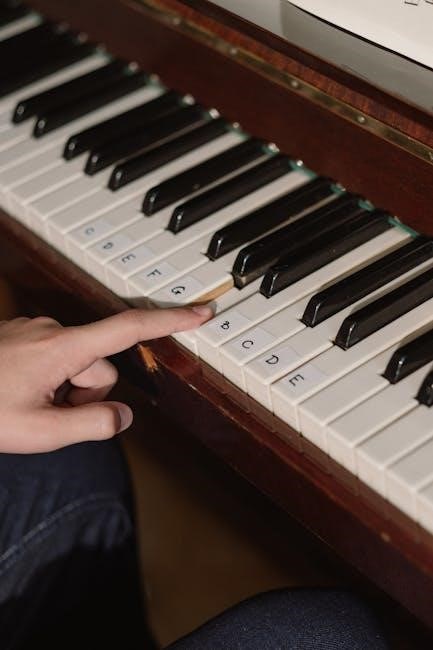A piano keyboard chord chart is a visual guide displaying keys, notes, and chord layouts, essential for learning and mastering chord structures․ It simplifies music theory and enhances playing techniques for all skill levels․
What is a Piano Keyboard Chord Chart?
A piano keyboard chord chart is a visual tool designed to illustrate the layout of chords on a piano keyboard․ It maps out the keys and their relationships, showing which notes combine to form specific chords․ This chart is essential for musicians, as it provides a clear, organized way to understand chord structures․ By visually representing the keyboard, it helps users identify root notes, thirds, fifths, and other components of chords․ The chart typically includes major, minor, seventh, and other variations, making it a comprehensive resource for practice and performance․ Whether for beginners learning basic chords or advanced players exploring complex harmonies, a piano keyboard chord chart serves as a foundational guide for mastering chord playing․

Importance of Using a Chord Chart for Piano Learning
Using a chord chart is fundamental for efficient piano learning, as it provides a clear, visual representation of chords and their finger placements․ This tool accelerates the learning process by simplifying complex music theory concepts․ Beginners can quickly identify notes and intervals, while intermediate players can refine their techniques and explore advanced chords․ The chart also enhances creativity, allowing musicians to experiment with compositions and improvisations․ By breaking down chords into manageable patterns, it reduces intimidation and builds confidence․ Additionally, chord charts are versatile, catering to all skill levels and musical styles․ They serve as a practical companion for both practice and performance, ensuring mastery of chord progressions and harmonic structures․ This visual aid is indispensable for anyone aiming to improve their piano skills and deepen their understanding of music․

Benefits of Using a Piano Keyboard Chord Chart
A piano keyboard chord chart simplifies learning, accelerates chord recognition, and enhances composition skills, making it an indispensable tool for musicians of all levels and styles․
Advantages for Beginners
A piano keyboard chord chart is an invaluable tool for beginners, simplifying the process of learning chord structures and note placements․ It provides a clear visual representation of the keyboard, making it easier to identify keys and understand their relationships․ Beginners can quickly locate root notes, thirds, fifths, and other intervals, which are essential for building chords․ The chart also helps in memorizing chord shapes and patterns, reducing the complexity of music theory․ By using a chord chart, new learners can focus on hand positioning and finger placement without getting overwhelmed by the technical aspects․ It also serves as a reference for practicing scales and arpeggios, laying a strong foundation for further musical development․ This visual aid accelerates the learning process, builds confidence, and makes playing the piano more enjoyable from the start․
How It Helps Intermediate Players
For intermediate players, a piano keyboard chord chart serves as an invaluable tool for expanding musical knowledge and refining skills․ It provides a clear visual representation of complex chord structures, allowing players to explore advanced harmonies and variations․ By mapping out chord progressions, intermediate pianists can better understand how to transition smoothly between chords, enhancing their ability to play intricate songs․ The chart also aids in identifying key patterns and relationships, making it easier to improvise and compose music․ Additionally, it helps in developing finger dexterity and improving sight-reading abilities․ Overall, a chord chart bridges the gap between basic and advanced playing, offering a comprehensive guide to mastering more sophisticated techniques and expanding musical creativity․

Benefits for Advanced Musicians
For advanced musicians, a piano keyboard chord chart serves as a versatile tool for exploring complex harmonies and refining techniques․ It allows for quick visualization of chord structures, enabling seamless integration of extensions, alterations, and substitutions․ This enhances improvisation and composition by providing a clear roadmap for harmonic exploration․ Advanced players can also use the chart to analyze and map intricate chord progressions, ensuring precision and depth in their performances․ Additionally, it facilitates the study of chord inversions and voicings, which are critical for creating rich, layered soundscapes․ The chart’s visual clarity simplifies the process of experimenting with advanced techniques, making it an indispensable resource for musicians aiming to push their creative boundaries and mastery of the keyboard․

How to Read a Piano Keyboard Chord Chart
Understanding the piano keyboard chord chart involves recognizing key layouts, note patterns, and chord structures․ It visually organizes music theory, making it easier to identify and play chords effectively online․
Understanding the Layout of the Chart
The piano keyboard chord chart is designed to visually represent the piano keys and their corresponding notes, making it easier to identify chord structures․ Typically, the chart displays the 88 keys of a standard piano, arranged in a linear fashion with white and black keys․ Each key is labeled with its note name (e․g․, C, C#, D) and sometimes includes octave numbers for clarity․ Chords are mapped by grouping keys that form specific chord shapes, such as major, minor, or seventh chords․ The layout often highlights root notes and intervals, allowing players to quickly locate chord formations․ Some charts use color-coding or symbols to differentiate between chord types, while others may include finger placement guides․ This clear visual organization helps musicians of all levels to interpret and play chords accurately, whether they are reading sheet music or improvising․
Identifying Keys and Note Patterns
Identifying keys and note patterns is fundamental to using a piano keyboard chord chart effectively․ The chart visually maps the piano keys, distinguishing between white and black keys, and their corresponding notes․ By understanding the pattern of whole and half steps, musicians can locate root notes, thirds, fifths, and other intervals essential for chord formation․ This visualization aids in recognizing major and minor scales, as well as their variations, such as harmonic and melodic minors․ The chart also highlights common chord structures, such as triads and seventh chords, by grouping relevant keys together․ Advanced players can identify extended intervals and altered notes, enabling the exploration of diminished, augmented, and modal interchange chords․ This feature is particularly useful for composing and improvising, as it provides a clear roadmap for harmonic progressions and melodic development․ The ability to identify keys and note patterns transforms the chart into a powerful tool for both learning and creativity․

Common Piano Chords and Their Representations
Common piano chords include major, minor, and seventh chords, each represented by specific key combinations․ These charts visually map chords, making it easier to identify notes and play melodies․
Major Chords and Their Variations
Major chords are foundational in music, consisting of a root note, a major third, and a perfect fifth․ They create a harmonically rich and uplifting sound․ Common major chords include C, G, and F․ Variations like add9, sus4, and maj7 expand their harmonic depth․ For example, a C major chord can become a Cadd9 by adding the 9th note or a Csus4 by replacing the third with the fourth․ These variations add complexity and emotion to compositions․ A piano keyboard chord chart simplifies learning these chords by visually mapping keys and intervals, making it easier to identify patterns and finger placements․ This visual aid is invaluable for musicians aiming to diversify their harmonic vocabulary and explore creative possibilities in their playing or composition․ By mastering major chords and their variations, pianists can enhance their musical expression and versatility across genres․
Minor Chords and Their Variations
A minor chord is a three-note chord consisting of a root, a minor third, and a perfect fifth, creating a melancholic sound․ On the piano keyboard chord chart, minor chords are represented by their root note followed by a minor third and a perfect fifth․ For example, the A minor chord (A, C, E) is visually identifiable by the pattern of keys on the chart․ Variations of minor chords include the minor seventh (e․g․, A minor 7: A, C, E, G) and the half-diminished chord (e․g․, A minor 7b5: A, C, Eb, G)․ These variations add depth and complexity to music, making minor chords versatile for various genres․ The chart helps pianists quickly locate these chords and their variations, enhancing both practice and performance․ By studying the chart, musicians can master minor chords and their applications in compositions and improvisations․
Seventh Chords and Their Variations
Seventh chords are essential in music, adding depth and emotion to compositions․ They consist of a root, third, fifth, and seventh notes, creating a richer sound than basic triads․ On a piano keyboard chord chart, these chords are represented by their root key and the interval pattern of the seventh․ Major seventh chords (e․g․, Cmaj7) feature a major triad with a major seventh, while minor seventh chords (e․g․, Cm7) combine a minor triad with a minor seventh․ Dominant seventh chords (e․g․, C7) include a major triad and a minor seventh, often used in jazz and blues․ The chart visually maps these structures, helping pianists identify and play them effortlessly․ Seventh chords are versatile, enhancing melodies and harmonies in various musical genres, from classical to contemporary․ By mastering these variations, pianists can expand their expressive range and improve their overall playing skills․

Advanced Techniques for Using a Chord Chart
Advanced techniques include mastering chord inversions, exploring complex progressions, and applying harmonic substitutions․ These methods enhance musical depth and versatility, allowing for sophisticated improvisation and composition․
Chord Inversions and Their Applications
Chord inversions are rearrangements of a chord’s notes, offering new harmonic possibilities․ A root position chord has its root as the lowest note, while first and second inversions place the third and fifth, respectively, in the bass․ This technique adds variety and smoothness to musical passages, making it easier to transition between chords․ Inversions are particularly useful in harmonizing melodies, reharmonizing songs, and creating intricate bass lines․ For example, using a C Major chord in first inversion (E-G-C) can lead seamlessly into a G Major chord․ Advanced pianists often use inversions to enhance emotional expression and create dynamic shifts in music․ A piano keyboard chord chart can help identify these inversions visually, ensuring accurate and expressive performance across various musical styles, from classical to jazz and pop․
Chord Progressions and How to Map Them
A chord progression is a sequence of chords played in a specific order, forming the harmonic foundation of music․ Mapping these progressions using a piano keyboard chord chart helps musicians visualize and organize chord relationships․ By identifying common patterns like I-IV-V or ii-V-I, players can create cohesive and emotionally resonant music․
Using a chord chart, one can label each chord’s root note, quality, and inversion, making it easier to transition between chords․ This tool is invaluable for composers and improvisers, as it reveals how chords function within keys and how to modulate effectively․ Advanced techniques, such as reharmonization, become more accessible when progressions are clearly mapped․ Regular practice with chord charts enhances familiarity with harmonic structures, leading to greater musical fluency and creativity․

Resources for Downloading a Piano Keyboard Chord Chart PDF
Discover top websites offering free piano keyboard chord charts, such as Piano Nanny and Musicnotes, along with premium resources like Piano Marvel for detailed, high-quality PDF downloads․
Top Websites Offering Free Chord Charts

Several websites provide free piano keyboard chord charts in PDF format, making it easy for musicians to access essential resources․ Virtual Piano offers interactive tools and downloadable charts for beginners․ Piano Nanny provides comprehensive chord charts with visual layouts for easy learning․ Musicnotes and Piano Chords also offer extensive libraries of free chord charts․ Additionally, websites like Piano Marvel and HDpiano share detailed charts tailored for different skill levels․ These resources are perfect for both learners and educators, offering a variety of formats and styles to suit individual needs․ Whether you’re looking for major, minor, or seventh chords, these platforms ensure you have everything you need to improve your playing skills․ Their user-friendly interfaces and downloadable options make learning and practicing piano chords convenient and accessible for everyone․
Premium Resources for Detailed Chord Charts
Premium resources offer high-quality, detailed piano keyboard chord charts, often with advanced features like interactive tools and customizable layouts․ Websites like Piano Marvel and Piano Nanny provide extensive libraries of chord charts in PDF format, catering to both beginners and advanced players․ These resources frequently include video lessons, practice exercises, and progress tracking․ For instance, Skoove offers an AI-powered platform with personalized lessons and chord charts․ Additionally, platforms like TrueGuitar and Piano Companion provide detailed chord diagrams and note patterns, ideal for composing and improvising․ Premium resources often include exclusive content, such as chord progressions for popular songs and advanced techniques like inversions․ These tools are invaluable for musicians seeking a deeper understanding of chord structures and their applications in various musical styles․

Practical Applications of a Piano Keyboard Chord Chart
A piano keyboard chord chart is invaluable for composition, teaching, and live performances, offering a quick reference for chord structures and enhancing improvisation during musical sessions․
Using the Chart for Composition
A piano keyboard chord chart is an invaluable tool for composers, offering a visual representation of chords and their relationships․ It allows creators to experiment with chord progressions, harmonies, and key transitions effortlessly․ By mapping out chords on the chart, composers can visualize how notes interact, making it easier to craft cohesive and emotionally resonant music․ The chart also helps in identifying chord substitutions and variations, enabling the creation of unique and complex compositions․ For beginners, it simplifies the process of building songs from scratch, while advanced composers can use it to explore intricate harmonic structures․ Whether writing melodies, arranging accompaniments, or layering textures, the chart serves as a roadmap, ensuring compositions are both structured and innovative․ It’s a timeless resource for translating musical ideas into tangible, polished pieces․
Improvisation Techniques with the Chart
Using a piano keyboard chord chart can revolutionize your improvisation skills by providing a clear visual framework․ It helps identify chord progressions and scales, allowing for spontaneous creativity while maintaining harmonic coherence․ Beginners can experiment with random key presses, guided by the chart to explore chord relationships․ Advanced players can use it to map out complex improvisations, ensuring smooth transitions between chords․ The chart also aids in understanding key signatures and note patterns, making it easier to craft melodies on the fly․ By practicing with the chart, musicians can develop muscle memory and theoretical awareness, enabling them to improvise confidently․ It’s a powerful tool for transforming inspiration into music effortlessly, whether for composition, performance, or casual play․ The chart becomes a bridge between theory and practice, fostering artistic expression and technical precision simultaneously․
Teaching and Learning Tools
A piano keyboard chord chart serves as an invaluable resource for both educators and students․ It provides a clear, visual representation of chord structures, making complex music theory concepts more accessible․ Teachers can use these charts to demonstrate how chords are formed and relate to the keyboard layout, while students benefit from having a reference to practice and reinforce their learning․ Many interactive tools and apps now incorporate chord charts, offering personalized lessons and exercises․ For example, platforms like Skoove use AI to guide learners through chord progressions, while virtual pianos allow real-time visualization of notes and chords․ These tools not only simplify the learning process but also make it more engaging, encouraging consistent practice and creativity․ Whether for classroom instruction or self-study, chord charts are indispensable for fostering musical understanding and skill development․